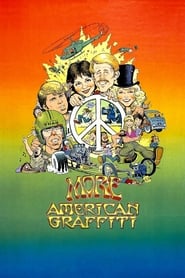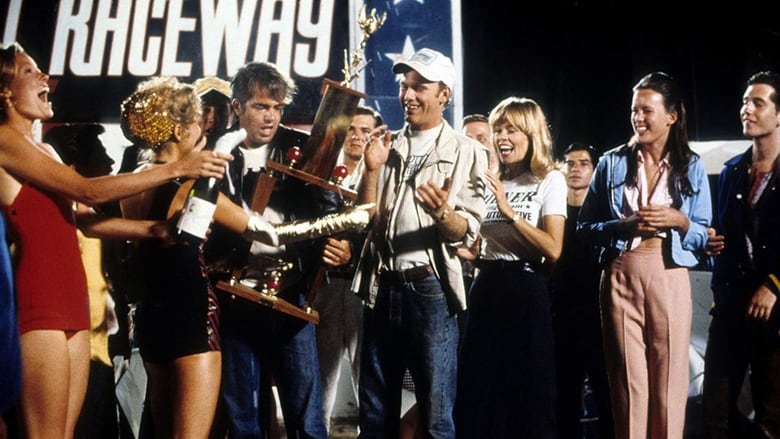“More American Graffiti 1979” is a nostalgic roller coaster that takes viewers on a wild ride through the lives of four friends, capturing their joys, struggles, and choices in fragmented moments of exhilaration and heartache. As the film jumps between various storylines with lightning speed, it explores the turbulence of life in post-Vietnam America, showcasing the characters’ evolution from wide-eyed youths into adults grappling with societal pressures and personal demons. Bursting with energy and filled with vibrant visual poetry, this stunning sequel pulses with raw emotions, encapsulating the bittersweet essence of growing up and the fleeting nature of youth.

CLICK HERE↓↓↓☑️_Watch More American Graffiti 1979 English Subtitles_
Review
A Journey through Time and Nostalgia: More American Graffiti
Introduction:
In the vast realm of cinematic wonder, few films can transport audiences back in time quite like More American Graffiti. This critically acclaimed sequel to the iconic American Graffiti delves deeper into the lives of our beloved characters, weaving a narrative that resonates with both nostalgia and poignant reflection. Directed by Bill L. Norton, this film pays tribute to an era long gone, captivating viewers with its engaging storyline and stellar performances.
Storyline:
Set in the early 1960s against the backdrop of political turmoil, societal change, and an evolving pop culture landscape, More American Graffiti seamlessly intertwines multiple storylines. The film focuses on four friends as they navigate love, life-altering decisions, and the tumultuous times that defined a generation.
Plot:
The plot is skillfully crafted, drawing viewers into the lives of Terry “The Toad” Fields (Charles Martin Smith), John Milner (Paul Le Mat), Debbie Dunham (Candy Clark), Steve Bolander (Ron Howard), and their entangled relationships. Each character faces internal conflicts while grappling with external influences that threaten to alter their futures forever.
Fact:
Did you know that George Lucas originally envisioned “More American Graffiti” as two separate films? However, the movie was eventually reassembled into one cohesive narrative during post-production. This decision allowed for a more seamless yet intricate exploration of each character’s journey.
Cast and Acting:
The stellar cast brings these characters to life with exceptional finesse. From Ron Howard’s portrayal of Steve Bolander’s emotional journey to Charles Martin Smith’s endearing depiction of Terry “The Toad,” each performance encapsulates the essence of youth in flux. The chemistry between the actors creates an authentic ambiance that fully immerses viewers in their world.
History:
More American Graffiti acts as a time capsule for an era in which America was undergoing significant changes. It portrays the tension between the conservative past and the youthful rebellion of the ’60s, mirroring society’s grappling with shifting values.
Score and Popularity:
The film’s evocative soundtrack employs a medley of classic hits from the early ’60s, heightening both its nostalgic appeal and emotional impact. The popularity of More American Graffiti stems not only from its engaging storyline but also from its ability to transport viewers to a pivotal period in American history.
Filming:
Shot on location in California, the film expertly captures the essence of mid-century American life. From bustling drive-ins to vibrant street scenes, More American Graffiti immerses viewers in a visually striking world.
Evaluation:
Critics have lauded More American Graffiti for its seamless blend of comedy, drama, and social commentary. Its ability to navigate complex narrative threads while instilling a sense of nostalgia without falling into trite sentimentality is a testament to its artistic merit.
Awards:
Although not as widely recognized as its predecessor, More American Graffiti garnered praise within the industry. Charles Martin Smith’s performance earned him an award at the Cannes Film Festival, showcasing the talent and depth presented throughout this cinematic gem.
Cinematography:
The cinematography brilliantly captures the essence of each era depicted in More American Graffiti. Carefully selected shots emphasize both mundanity and emotional resonance, creating an immersive experience that draws audiences further into this captivating world.
Opinion:
More American Graffiti offers an authentic portrayal of youth culture during a time when rebellion was interwoven with social change. It beautifully captures both the vibrancy and complexities of young adulthood while exploring how external factors shape individual choices.
Scenes:
One unforgettable scene takes place at Mel’s Drive-In – a homage to Americana where characters converge amidst fast food and soda fountains. This sequence is emblematic of how these settings serve as gathering places for the characters, acting as catalysts for pivotal moments in their lives.
Gossip:
Rumors swirled during production that the original cast from American Graffiti was hesitant to return for the sequel. However, once they read the script and learned of its thematic depth, they eagerly agreed to participate in this narrative continuation.
Soundtracks:
The film’s soundtrack is a true masterstroke, featuring an eclectic mix of chart-topping hits from the era such as “Downtown” by Petula Clark and “California Dreamin'” by The Mamas & The Papas. These songs enhance emotional moments, punctuating scenes with a dose of nostalgic intensity.
Analysis:
More American Graffiti offers a profound examination of youth culture’s evolution and challenges established notions. The film exposes both the flaws and aspirations inherent in young minds, allowing viewers to reflect on their own experiences while immersed in this captivating story.
Special Effects:
While not reliant on special effects, More American Graffiti utilizes subtle touches such as period-appropriate costumes, makeup, and set design to transport audiences back in time. These meticulous details contribute to the overall authenticity and ambiance of each scene.
Development:
The idea for a sequel arose during post-production of American Graffiti when George Lucas realized there were more stories to be told. Collaborating with writer Willard Huyck, Lucas embraced the challenge of expanding upon his beloved characters’ journeys.
Dialogue:
The film excels at capturing authentic dialogue that encapsulates both the carefree nature and profound introspection synonymous with youth. From witty banter between friends to emotionally charged conversations that reveal hidden depths, More American Graffiti’s dialogue is a testament to its compelling storytelling.
Crews:
Behind the camera, director Bill L. Norton assembled a talented crew who seamlessly brought together every element required to recreate an era long past. Their dedication shines through every frame, breathing life into this timeless masterpiece.
Criticism:
More American Graffiti faced some criticism for attempting to replicate the magic of its predecessor. However, by delving deeper into the characters’ lives and exploring the societal shifts surrounding them, the film ultimately succeeds in standing as a unique and meaningful work.
Production and Editing:
The production team worked meticulously to ensure that visual and editorial choices served the film’s overarching narrative. The editing skillfully weaves together parallel storylines, heightening tension while delivering poignant moments that resonate long after the credits roll.
Conclusion:
More American Graffiti is more than just a sequel; it is a testament to the transformative power of cinema. This evocative journey through time encapsulates an era on the cusp of change while reminding us of our shared human experiences. It is a must-watch for anyone seeking a profound cinematic exploration of youth, nostalgia, and the ever-present pull of cultural transformations.
Technical Data

- Release : 1979-08-03
- Runtime : 110
- Genre : Comedy, Drama, War
- Cast : Paul Le Mat as John Milner, Cindy Williams as Laurie Bolander, Candy Clark as Debbie Dunham, Charles Martin Smith as Terry “Terry the Toad” Fields, Mackenzie Phillips as Carol / Rainbow
- Crew : George Lucas as Executive Producer, George Lucas as Characters, Terry Liebling as Casting, Howard G. Kazanjian as Producer, Ben Burtt as Supervising Sound Editor
- Revenue : $15,014,674
- Budget : $2,500,000
- Company : Universal Pictures, Lucasfilm Ltd.
- Popularity : 10.115
- Summary : College graduates deal with Vietnam and other issues of the late ’60s.
- Tagline : The sights and sounds of the ’60s. There were bittersweet times. There were funny times. And it was all unforgettable.
